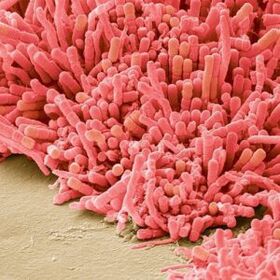
Papilloma is a benign skin neoplasm, the characteristic feature of which is a papillary base made of connective tissue, which is covered with epithelium on top. Papillomas occur in humans in different areas of the body (on the skin, mucous membranes, in internal organs and other locations) and in most animals.
Papillomas develop from the transitional or flat epithelium in the form of soft, dense formations on the so-called pedicle. These formations usually range in size from 1 to 2 cm in diameter, and their outer surface is white or dirty brown in tint. Sometimes papillomas grow in different directions and become like cauliflower or rooster comb.
Papillomas are removed for cosmetic reasons when they appear in visible areas of the body - the neck, arms and face. However, if they occur in many areas of the mucous membrane, e. g. B. on the larynx, patency disorders can be caused that threaten the life of the patient. In the case of the larynx, a papilloma can block the airway and cause problems with voice or the inability to breathe normally. In the case of the bladder, papillomas cause hematuria. If several papillomas form on the body, this indicates the onset of papillomatosis.
Etiology of papillomas
The occurrence of papillomas is largely caused by a viral infection - human papillomavirus (HPV) - although papillomas can sometimes be congenital or complications of inflammatory diseases.
When HPV gets into the human body, its activity usually begins to manifest itself after a long time. Often some provoking factors contribute to the activation of the papillomavirus, as a result of which soft neoplasms appear on the skin or mucous membranes. The main factors that provoke papillomas are stress, decreased immunity, weakening of the body due to treatment, lack of vitamins in the body, skin damage.
Basically, people are sexually infected with papillomavirus. However, there are also cases of domestic infections with very low immunity or the presence of damaged areas of skin on the body that may come into contact with an HPV carrier. The appearance of papillomas indicates the activation of the virus present, which is equally possible for women and men. A baby can become infected with this virus while passing through the birth canal of an infected mother.

Classification of HPV manifestations
The human papillomavirus, which infects mucous membranes and skin, can be divided into the following forms:
- clinical form that can be found during routine examination: genital, papular and papillary warts, exophytic warts, as well as cervicitis and cervical erosion in women;
- subclinical form in which the formations have no symptoms, are not visible and can only be detected during endoscopy: inverting formations (that grow to the inside of the mucous membranes), flat warts, as well as warts in the cervical canal;
- latent form, characterized by the absence of a clinic and proven exclusively by the results of analyzes;
- feminine form or cervical form, expressed by cervical cancer or dysplasia in various stages.
When women are infected with highly oncogenic HPV through sexual contact, the likelihood of malignant neoplasia in the cervical canal increases dramatically. If you are infected with other types of viruses, the likelihood of oncology is not as high. However, a cancerous tumor may appear in the rectum or oral cavity. Men are more likely to develop cancer from HPV in the anus, penis, and rectum.
Types and shapes of papillomas
It is very important to correctly identify papillomas that appear on the body. Their types are directly dependent on the strain of the resulting virus, which, when entering the human body, contributes to the process of excessive cell division in the skin and leads to papillomas.
HPV strains can be oncogenic and non-oncogenic. There are many more non-oncogenic varieties which, as a rule, only bring external aesthetic discomfort to the patient.
Such a manifestation can be easily removed, thereby solving the problem. However, if there are neoplasms in the area of the mucous membranes, then this indicates serious pathological processes. Such a dislocation means that a person has been infected with an oncogenic strain of HPV, which is why complex antiviral therapy is extremely necessary. To distinguish between different types of papillomas, it is enough to simply compare them with each other and identify the distinguishing features of one or another subspecies.

Simple warts
Simple papillomas, or warts, are the most common type of papillomavirus, caused by multiple strains at the same time. These strains of HPV are not only transmitted sexually, but also through contact and everyday life, leading to statistics showing that 30% of the world's population have encountered such HPV at least once in their life.
Simple papillomas or vulgar (common) warts are more common than other places on the upper extremities, namely the hands, but sometimes they can also appear on the body, the soles of the feet and feet, the palms of the hands and the fingers. Their peculiarity is that such warts appear in places with damaged skin due to a decrease in local immunity. Such papillomas appear in the area of the soles of the feet or palms of the hands due to contact with poor-quality household chemicals, profuse sweating, various skin damage and dermatitis.
The vulgar wart looks like papillary skin neoplasms with a diameter of a few millimeters at the beginning of the disease. In this case, the wart head has a homogeneous and soft texture and rises above the surface of the skin. It is poorly pigmented and its roots reach deep into the skin, where the vessels feed it. As a result of such a diet, the warts gradually grow, while changing not only their size, but also the degree of pigmentation. In addition, hair often grows in the center of such papillomas, which is a variant of the norm and does not indicate a malignant neoplasm.
Flat papillomas
Skin growths like this one look like small yellowish flat plaques that rise slightly above the surface of the skin. Their structure is dense, with a deep subcutaneous root, which manifests itself in frequent pain when pressing on the wart or damage in everyday life. The localization of such papillomas is most often the face and hands. Sometimes they can appear in the anus or labia in women and in the scrotum in men. Because of the active blood supply, they have an active upward trend.
The main characteristic of flat papillomas is the difficulty of their treatment. After surgical treatment for these neoplasms, scars and scars usually remain in their place.
Genital warts
Genital warts appear in the groin area or in the mucous membranes. Outwardly, these are thin papillary neoplasms with a diameter of 2-3 millimeters. Such condylomas grow quickly and form a large skin growth from a small papilla, similar to a cauliflower or a cockscomb.
The main danger of genital warts is the high risk of infection, the inflammation of neoplasms in the vagina or the labia minora in women. They can be easily injured, after which the infection enters the body at a high rate. Also, a major problem associated with genital warts is the high risk of their recurrence, which even with the use of antiviral treatment and the removal of neoplasms is not reduced. Several strains of the virus can cause genital warts, some of which can be dangerous for women in terms of the malignant process.

Filiform papillomas
Papillomas with a thread and a thin stalk, the top of which is crowned by the head of the neoplasm. Due to their special appearance, they are very difficult to confuse with other species. Looking at the photo of filamentous papillomas, they can be distinguished from other varieties.
Such neoplasms most often appear after the age of 45 in areas where thin skin predominates - on the chest, armpits, neck. The increase in the size of such neoplasms is their further elongation. The head of filamentous papillomas is usually yellowish or pink, the pigmentation is not pronounced, usually very weak.
Internal birthmarks
Any neoplasm on the surface of a person's internal organs can be classified as a subgroup of internal birthmarks. These are intragastric condylomas, papillomas in the rectum, neoplasms in the throat and mouth, neoplasms on the walls of the bladder. A peculiarity of these papillomas is the impossibility of their detection without performing appropriate medical procedures and diagnoses. However, the disease can be suspected by specific symptoms. The risk of such neoplasms is identified in each case.
If there are papillomas in the bladder, bleeding or cancer can develop over time.
If the papilloma is in the larynx, it helps block breathing and interferes with the person's ability to speak.
Lewandowski-Lutz papillomas
Warty epidermodysplasia or Lewandowski-Lutz papillomas are a very rare pathology that mainly affects only children or adolescents. It happens that such a disease can be inherited and spread in a family.
The clinical picture manifests itself in the form of numerous reddish-brown spotted warts in the area of the feet and hands. A feature of the pathology is the fact that if papillomas are located in areas of the body exposed to ultraviolet radiation, in a third of all cases they are reborn into malignant neoplasms and grow into the area of neighboring tissues.

Locations of papillomas
Filamentous, vulgar or pointed papillomas and condylomas are the most common in the doctor's office. The place of localization of filamentous warts is the face, vulgar warts are more often in the area of the feet or hands, and condylomas are located exclusively on the mucous membranes (the head of the penis and in the urethra in men, in the area of the labia minora and vaginain women), but it happens that none of these warts can appear in any unusual place on their own.
It is not difficult to remove such papillomas in modern conditions, but the danger is that with a decrease in immunity, new papillomas can reappear, which can lead to more serious health consequences. For example, the later appearance of genital warts is fraught with the development of cervical cancer in the womb. Plantar warts are most common on rough soles and toes. Occasionally, a thorn on the thumb may develop after severe skin damage in the area.
In general, papillomatosis is a generalized form of pathology in which neoplasms form throughout the human body. These growths have a characteristic appearance. Once they have seen the manifestations of the disease, they can no longer be confused with other diseases.
HPV symptoms
The most common symptom of papillomavirus in the human body is the appearance of papillomas on the skin.
The rest of the symptoms depend directly on the location and type of illness. Depending on the signs above, HPV symptoms could be any of the following:
- Genital warts appear on the mucous membranes of the genitals, mouth, larynx, rectum, and on the inner surface of the stomach. Symptoms of the onset of pathology in the genital area are itching and an unpleasant odor. If such symptoms begin to bother them, in any case they should not be ignored, since very often the cause of their appearance can be oncogenic in nature.
- Intraductal papillomas in the area of the mammary ducts, the signs of which are redness in the nipple area, slight itching and burning. If you press on the nipple with such a papilloma, an ichor or green discharge will begin to ooze from it. The danger of intraductal papilloma is its gradual and possible degeneration into breast cancer.
- Plantar warts are expressed as active calluses in the area of the soles of the feet, which cause sharp pain when walking or pressing.
- Papillomas in the larynx area are not initially expressed in a specific symptomatology, but gradually this pathology leads to a change in a person's voice, a coma in the throat and impaired respiratory functions. In addition, the patient begins to have difficulty swallowing.
- Flat warts most often appear on the outside of the hands and lower part of the face in adolescents. The symptoms are very blurred and usually manifest themselves in a slight, rare itching of the neoplasia.

Pathogenesis
In the presence of HPV in the human body, it can often be concluded that immunity is decreased. As soon as the viruses are in the body, they begin the process of infecting the basal epithelial layer, the main tendency being to affect the transition area from squamous to cylindrical squamous epithelium. Two forms of the virus can exist in infected cells - episomal (outside the cell chromosomes) with a benign nature and introsomal (integrated into the genome of cells) with a malignant parasitic nature.
The incubation period of the papillomavirus can vary from the entry of the virus into the body to the first manifestations of the disease within a period of 14 days to a few years. The nature of human papillomavirus infection is usually latent, that is, hidden. At the same time, several types of pathologies can settle in the human body at the same time, and under the influence of certain factors, each of them can simultaneously manifest itself through active reproduction. In this case, the stage of the disease occurs when clinical manifestations begin to be identified.
Very often (up to 90% of all cases of HPV infection) the human body heals from this pathology for 6-12 months, but in 10% of the remaining cases the disease can become chronic with a long course, relapsesand the possibility of malignancy of the process.
Disease diagnostics
Ultrasound for papillomas
When diagnosing papillomas, ultrasound is used not as the main research method, but as an additional method to confirm the accuracy of the alleged diagnosis. Basically, ultrasound is used to diagnose papillomas in internal organs when it comes to their malignant transformation.
Ultrasound is used among the instrumental verification techniques for diagnosing intraductal papilloma.
Conducting an ultrasound scan in this case does not allow the specialist to examine the ducts of the mammary glands. However, it helps to differentiate intraductal papilloma from suspected breast cancer and enables galactorrhea to be excluded in prolactinoma. Ultrasound can also help detect the appearance of neoplasms with papilloma of the bladder. However, in this case, ultrasound is only effective if the neoplasms are more than 1 cm in diameter.

PCR diagnosis during diagnosis
The diagnosis of the disease in question is carried out by doctors, dermatologists and venereologists. Since the number of virus types varies, it is important to determine exactly what type the patient is infected with and whether this strain has an oncogenic character. An exact diagnosis is only possible visually in the case of classic genital warts, which is why specialists always use PCR scraping if an HPV infection is suspected.
The polymerase chain reaction (PCR) prompts researchers not only to determine the presence of HPV in the body, but also to demonstrate its type, oncogenicity and number of viruses at the time of diagnosis. This is very important for diagnostics, since information about the percentage of the virus in the body can be used to determine the approximate date of infection and the contact persons of the patient can be determined in order to carry out etiotropic therapy.
Based on the results of the PCR diagnostics, it is possible to determine the chronic course of the infection or its one-off outbreak due to reduced immunity. This information gives the specialist an opportunity to prescribe a therapy that is appropriate for a particular case. As a rule, PCR diagnostics are carried out in the form of a screening. If the presence of a virus in the body is confirmed, the patient will continue to be examined using other techniques.
HPV biopsy
The biopsy in medicine refers to the procedure for taking samples of human tissue for subsequent examination by staining with special dyes. A biopsy is very common in both cancer and suspected HPV. On the eve of treatment with papillomavirus, doctors need to exclude the oncological nature of neoplasms.
The biopsy is a high-precision diagnostic technique that can be expressed in cytological or histological studies if HPV is suspected.
The cytological examination is an examination of body cells under a microscope to demonstrate to professionals the changes that a viral infection has caused in these cells. For the prevention and early detection of cervical cancer, cells are taken from this organ for a cytological examination from a woman. If oncogenic HPV types are detected in women, even if there are no external manifestations and signs, they are assigned annual cytological studies so that they can detect signs of cervical dysplasia in a timely manner. The fact is that the dysplasia of this organ is completely curable. If you do not begin to develop the process, then even with an oncogenic type of virus, cervical cancer will not develop in the body at all.
In order to accurately diagnose HPV, a histological study is carried out, for which no superficial cell scraping is taken from the patient for analysis, but a piece of tissue that can be used to examine the correct position of cell layers, tissue features and oncological features. When performing a histological examination with the help of solutions, the removed tissue sample is dehydrated and embedded in paraffin. Sections are then made with a microtome in order to obtain layers with a thickness of 0. 1 millimeters. The removed layers are stained with special dyes in order to expose pathological cells during microscopic examination and to determine their nature.

Treatment of papillomatosis
The treatment of the papillomavirus always follows an individual scheme. If a virus is detected during diagnosis but has not yet manifested itself, the patient is prescribed etiotropic cytostatic therapy that effectively “lulls” the virus for several years.
If a person is a carrier of HPV, they should have regular PCR diagnostics to identify the first signs of the disease developing. In addition, the carrier of this virus is obliged to use a method of contraception so as not to infect sexual partners.
If papillomavirus is detected, antiviral agents must be used for treatment. In general, immunomodulatory and vitamin supplements are indicated for absolutely all patients with HPV.
If papillomas appear on the mucous membranes or the skin, depending on the location and symptoms, resort to cryodestruction, electrocoagulation and laser removal of the growths. Sometimes papillomas are removed using a more modern technique - using radio waves. If there are signs of papilloma malignancy, it is surgically excised along with the surrounding healthy tissues around the growth. It is also important to know that removing the papilloma does not result in a complete cure, as the virus remains in the body and can reappear.
In modern medicine, there are no drugs to completely eliminate this virus from the body. Therefore, if such a diagnosis is identified, then even without manifestations, a person must undergo regular examinations to determine the development of pathology.
Since the papillomavirus is most commonly transmitted sexually, it is worth choosing a barrier method of contraception. When a woman is planning a pregnancy, it is important to timely conduct diagnostic measures and resort to therapy that will reduce the chances of the child becoming infected with this virus.
Disease prevention
It is possible to prevent the appearance of papillomas on the body by observing the basic rules of personal hygiene and timely disinfection of wounds. It is imperative to use a separate towel, comb, manicure equipment and shoes for each family member in everyday life. Inconsistent sex should always be protected with condoms. After intercourse, it is also important to always shower and treat the areas of contact between the skin and mucous membranes, as it takes some time for the virus to enter the human body.
In modern medicine there is also a vaccine against papillomavirus. It has already been tested in 72 countries around the world and is effective against 16 and 18 subtypes of HPV, which cause cervical cancer in 90% of all diagnosed cases. The vaccination also successfully fights subtypes 6 and 11 viruses that provoke the development of genital warts that are difficult to treat. Because of the sexual route of infection with these viruses, it is recommended that a person be vaccinated before beginning sexual activity. In most cases, experts recommend using the vaccine three times for girls 11-12 years old. The World Health Organization recommends vaccinating boys as well to prevent the possibility of HPV circulation.
Are papillomas dangerous?
Papillomavirus is a risk factor for the development of oncological pathologies. Most often, due to this virus, cancer of the cervix, cancer of the external genital organs (vulva, glans) occurs. However, HPV infection does not always lead to cancer. There are many subtypes of this virus with a low oncogenic index, for example subtypes 6, 11, 42, 43, 44 that form condylomas, but there are also highly oncogenic subtypes - 16, 18, 31, 33 that produce flat warts. It can take 10 to 20 years from the virus entering the body to transforming a neoplasm into a malignant one.
If there are large papillomas on the body that can be damaged very easily in everyday life, they must be removed.
If the papillomavirus that is found in the body is not treated, the risk of contracting other infections increases dramatically. And in the course of parallel infection processes, papillomas appear in other parts of the body and weaken the immune system. It turns out to be a vicious circle. In addition, if some papillomas are not removed, they can degenerate into oncological neoplasms, which means that this disease must be approached with all seriousness and never take its course.

























